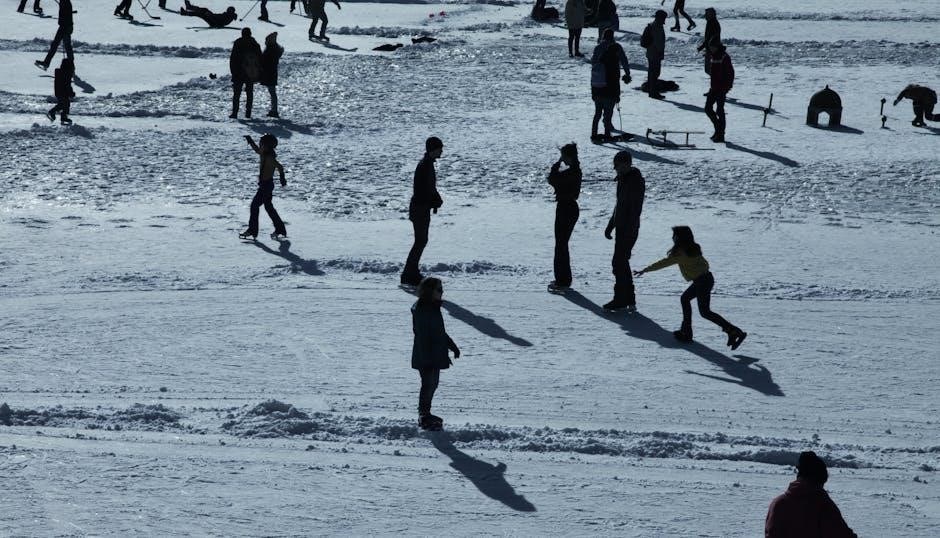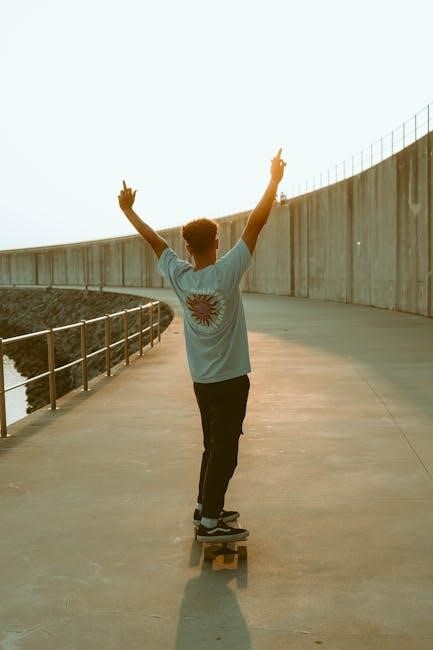skating ski length guide
Choosing the right skating ski length is crucial for optimal performance and efficiency. This guide explores key factors to help you select the perfect skis for your needs.
1.1 Importance of Proper Ski Length
Proper ski length is foundational for optimal performance and efficiency in skating. It directly impacts stability, control, and weight distribution, which are critical for precise technique and speed. A ski that is too long may be difficult to maneuver, while one that is too short can compromise balance and power generation. Correct length ensures better energy transfer and glide, enhancing overall skiing experience. Understanding and selecting the right length is essential for maximizing efficiency and enjoyment on the snow.
1.2 Overview of Skating Ski Characteristics
Skating skis are designed for speed and agility, typically shorter and stiffer than classic skis. Their sidecut is more pronounced, enabling better edge control and quicker turns. The camber profile is optimized for efficient glide and kick, while the waxless or skin-based kick zone ensures smooth movement. These skis often feature a shorter length, usually 10-15cm less than classic skis, allowing for precise maneuverability. Their construction emphasizes lightweight materials and a responsive flex, making them ideal for dynamic, high-intensity skiing. Understanding these characteristics helps in aligning the ski’s features with individual skiing styles and preferences.

Why Ski Length Matters in Skating
Ski length impacts performance, stability, and efficiency. Proper length ensures optimal glide, maneuverability, and control, directly affecting the skier’s experience and effectiveness on the snow.
2.1 Performance and Efficiency
A well-chosen skating ski length enhances performance and efficiency by optimizing glide and energy transfer. Skis that are too short may lack stability, while skis that are too long can hinder maneuverability. Proper length ensures that each stride is powerful and effective, allowing for better acceleration and maintaining rhythm. Efficiency is further maximized when the skis’ camber and construction are suited to the skier’s weight and technique, enabling consistent snow contact and smooth glide. This balance is essential for competitive and recreational skiers alike, as it directly impacts overall skiing performance and enjoyment on the snow.
2.2 Stability and Control
Stability and control are critical in skating, and ski length plays a significant role in achieving both. A ski that is too short may lack stability, causing it to wobble or lose track, especially at higher speeds. Conversely, a ski that is too long can feel unwieldy, making it difficult to maneuver or maintain control during turns. Proper ski length ensures that the skier can maintain balance and precision, with the skis responding smoothly to movements. This balance is essential for confident skiing, allowing the skier to focus on technique and navigation without struggling with equipment responsiveness.
2.3 Weight Distribution and Balance
Weight distribution and balance are directly influenced by ski length, as proper sizing ensures even weight dispersion across the ski surface. A ski that is too short may cause the skier’s weight to concentrate in the middle, reducing glide efficiency and making it harder to maintain balance. Conversely, a ski that is too long can feel cumbersome, disrupting the skier’s ability to shift weight effectively. The right ski length allows for optimal weight distribution, enabling smooth, balanced movements and better control over the skis. This balance is essential for maintaining rhythm and efficiency in skating technique, particularly during turns and acceleration.

Factors Influencing Skating Ski Length
Skating ski length is influenced by skier height, body weight, skiing style, and snow conditions. Proper fitting ensures optimal performance and efficiency.
3.1 Skier Height and Body Proportions
Skier height is a primary factor in determining skating ski length, as it affects balance and control. Taller skiers typically require longer skis for efficient gliding and stability.

3.2 Body Weight and Its Impact
Body weight significantly influences skating ski length, as lighter skiers may prefer shorter skis for easier control, while heavier skiers benefit from longer skis for stability and float.
3.3 Skiing Style and Technique
Skiing style and technique play a pivotal role in determining the ideal skating ski length. Skiers with an aggressive, dynamic style often prefer shorter skis for quicker turns and agility, while those with a more relaxed, gliding technique may opt for longer skis to maintain stability. The way a skier shifts weight, uses poles, and transitions between strides can also influence the optimal ski length. Proper technique ensures efficient energy transfer, and the right ski length supports this by aligning with the skier’s movement patterns. Thus, understanding your skiing style is essential for selecting skis that enhance performance and comfort on the snow.
3.4 Snow Conditions and Terrain
Snow conditions and terrain significantly impact the choice of skating ski length. Softer snow or uneven trails may require shorter skis for better maneuverability, while firm, groomed courses benefit from longer skis for glide efficiency. Skiers tackling hilly or varied terrains might prefer a medium length to balance stability and agility. The type of snow—wet, icy, or powdery—affects how the ski interacts with the surface, influencing length selection. Matching ski length to specific snow conditions and terrain ensures optimal performance, making it easier to navigate different environments effectively.

Common Misconceptions About Ski Length
Many believe ski length is solely determined by height or that one-size-fits-all, ignoring factors like weight, technique, and terrain, which also play crucial roles.
4.1 The Height-Only Approach
A common misconception is that ski length should be based solely on height. This approach ignores individual differences in body weight, skiing style, and terrain preferences. While height provides a general starting point, it doesn’t account for variations in technique or performance goals. For example, a taller skier who prefers lightweight skis for agility might opt for shorter skis, while a shorter skier needing stability might choose longer ones. Overlooking these factors can lead to suboptimal performance and discomfort. A more holistic approach is essential for selecting the right ski length.
4.2 One-Size-Fits-All Myth
The belief that one ski length suits all skiers is a widespread misconception. Ski length depends on various factors, including height, weight, skiing style, and terrain. A single size cannot accommodate the diverse needs of skiers, as body proportions, technique, and performance goals vary significantly. For instance, a lightweight skier may prefer shorter skis for agility, while a heavier skier might need longer skis for stability. Ignoring these differences leads to poor performance and discomfort. The one-size-fits-all approach oversimplifies the complexities of ski selection, emphasizing the need for personalized choices. Skiers must consider their unique requirements to find the optimal ski length for their needs.
How to Choose the Right Skating Ski Length
Selecting the right skating ski length involves measuring height, assessing skiing style, considering terrain, and using length charts. Proper fit ensures efficiency and control on the snow.
5.1 Measuring Your Height and Weight

Accurate measurement of height and weight is essential for determining the appropriate skating ski length. Stand tall with feet together to measure height, and use a scale for weight. These metrics help establish a baseline for ski length recommendations, ensuring proper fit and performance. Weight distribution affects ski responsiveness, so combining height and weight data provides a more accurate guide for selection. This step is fundamental in the process and ensures that subsequent considerations, like skiing style and terrain, are applied to the correct baseline measurements. Always use reliable tools for precise results.
5.2 Assessing Your Skiing Style
Understanding your skiing style is crucial for selecting the right ski length. Technique, aggression level, and preferred skiing type (e.g., racing, recreational, or touring) significantly influence the optimal length. Skiers with a more aggressive style may prefer shorter skis for better maneuverability, while those with a relaxed technique might opt for longer skis for stability and glide efficiency. Additionally, your skill level and how you distribute your weight on the skis play a role. Combining this assessment with height and weight measurements ensures a well-rounded approach to choosing the ideal ski length, enhancing both performance and comfort on the snow.

5.3 Considering Your Primary Skiing Terrain
Your primary skiing terrain is a critical factor in determining the ideal skating ski length. Skiers who frequent groomed, flat trails may benefit from longer skis for enhanced glide and speed. Conversely, those navigating uneven or hilly terrain may prefer shorter skis for easier control and maneuverability. Additionally, the snow conditions common to your skiing location—such as deep snow, ice, or wet conditions—affect the ski length choice, as shorter skis may perform better in softer snow, while longer skis excel on hard, smooth surfaces. Tailoring your ski length to the terrain ensures a more enjoyable and efficient skiing experience, adapting to the specific demands of your environment.
5.4 Using Ski Length Charts and Guidelines
While ski length charts and guidelines provide a helpful starting point, they are not one-size-fits-all solutions. Most charts consider height and weight as primary factors, but they may not account for individual skiing styles or terrain preferences. For example, skate skis are typically 10 to 15cm shorter than classic skis, but this can vary based on the skier’s technique and weight distribution. Always consult multiple sources and consider your unique needs. Practical testing on snow is the ultimate way to confirm the right length, as it allows you to assess how the skis perform in real conditions. This hands-on approach ensures the best fit for optimal performance and comfort.

Skate Ski vs. Classic Ski Length Differences
Skate skis are typically 10-15cm shorter than classic skis, designed for agility and speed, while classic skis prioritize glide and stability with their longer length.
6.1 Key Differences in Design and Purpose
Skate skis and classic skis differ significantly in design and purpose. Skate skis are shorter and wider, with a sidecut that allows for better maneuverability and edge control in groomed tracks. They are designed for dynamic, high-speed movements, emphasizing quick turns and powerful propulsion. Classic skis, by contrast, are longer and narrower, optimized for efficient gliding and rhythmic striding in snow. Their design supports longitudinal movement, making them ideal for endurance and touring. These differences in design directly influence the recommended lengths, with skate skis typically being 10-15cm shorter to enhance agility and performance.
6.2 Length Recommendations for Skate Skis

Skate skis typically range in length from 171cm to 191cm, with 5cm increments. The ideal length depends on the skier’s height, weight, and skiing style. For example, a skier around 173cm and 120lbs might opt for a 177cm ski, while taller or heavier skiers may prefer longer skis for stability. Generally, skate skis are 10-15cm shorter than classic skis, allowing for better agility and maneuverability. Proper fit ensures optimal performance, so consulting a size chart or seeking expert advice is recommended to find the perfect match for your needs and preferences.
Tips for Optimal Skating Ski Performance
Proper ski length enhances technique, while adjusting length by skill level ensures better control. Pairing skis with suitable boots and bindings optimizes overall performance and comfort.

7.1 Maintaining Proper Ski Length for Technique
Proper ski length is essential for optimal technique in skating. A ski that is too long can hinder agility and balance, while one that is too short may reduce glide efficiency. Ensuring the right length allows for better power transfer and smoother strides; Skiers should consult length charts and consider their height, weight, and skiing style to find the ideal fit. Regularly assessing and adjusting ski length as skill levels or body proportions change is crucial for maintaining proper form. Additionally, seeking advice from professionals can help fine-tune the fit, ensuring peak performance and comfort on the snow.
7.2 Adjusting Length Based on Skill Level
Adjusting the length of skating skis based on skill level is crucial for optimizing performance. Beginners often benefit from shorter skis, which provide better control and maneuverability, essential for learning basic techniques like turning and stopping. Intermediate skiers may prefer a moderate length that balances stability and agility, allowing them to refine their skills on various terrains. Advanced skiers typically opt for longer skis to maximize speed and glide efficiency, which is beneficial for competitive or challenging trails. It’s important to consider personal comfort and technique development, as well as seeking professional advice to ensure the chosen length aligns with individual needs and progression. Periodically reassessing ski length as skills improve can enhance overall skiing experience and efficiency.
7.3 Pairing Skis with Appropriate Boots and Bindings
Properly pairing skating skis with boots and bindings is essential for maximizing performance and comfort. Boots should offer a snug fit to ensure control and responsiveness, while bindings must be compatible with both the skis and boots. Ensuring that all components are well-aligned and securely fastened is critical for efficient energy transfer during each stride. Additionally, the boot’s flex and support should match the skier’s technique and intensity level. Incompatible or ill-fitting equipment can lead to reduced efficiency and increased fatigue. Always consult with a professional to ensure that the entire setup is optimized for individual needs, enhancing the overall skiing experience and performance.
Proper ski length is crucial for performance, efficiency, and balance, ensuring an optimal skating experience. Always consider height, weight, and technique when selecting skis for the best results.
8.1 Final Thoughts on Ski Length Selection
Selecting the right skating ski length is a balance between personal factors and skiing style. While height and weight are key, technique and terrain also play significant roles. Most adult skate skis range from 171cm to 191cm, catering to various body sizes and preferences. A common misconception is relying solely on height for sizing, but weight distribution and skiing intent are equally important. For example, lighter skiers might prefer shorter skis for agility, while heavier individuals may opt for longer skis for stability. Ultimately, testing different lengths can provide the best insight, ensuring a harmonious blend of performance and comfort on the snow.
8.2 Encouragement to Test and Experiment
Testing and experimenting with different ski lengths is a vital step in finding your ideal setup. Every skier’s needs are unique, and preferences may vary based on technique, terrain, and personal comfort. Don’t hesitate to try out various lengths to discover what works best for you. Many ski shops offer demo days or rental options, providing opportunities to experience different skis firsthand. This hands-on approach allows you to assess performance, stability, and maneuverability in real conditions. Remember, your skiing style and preferences may evolve over time, so staying open to adjustment is key. Experimentation can make a significant difference in your skiing enjoyment and success.
